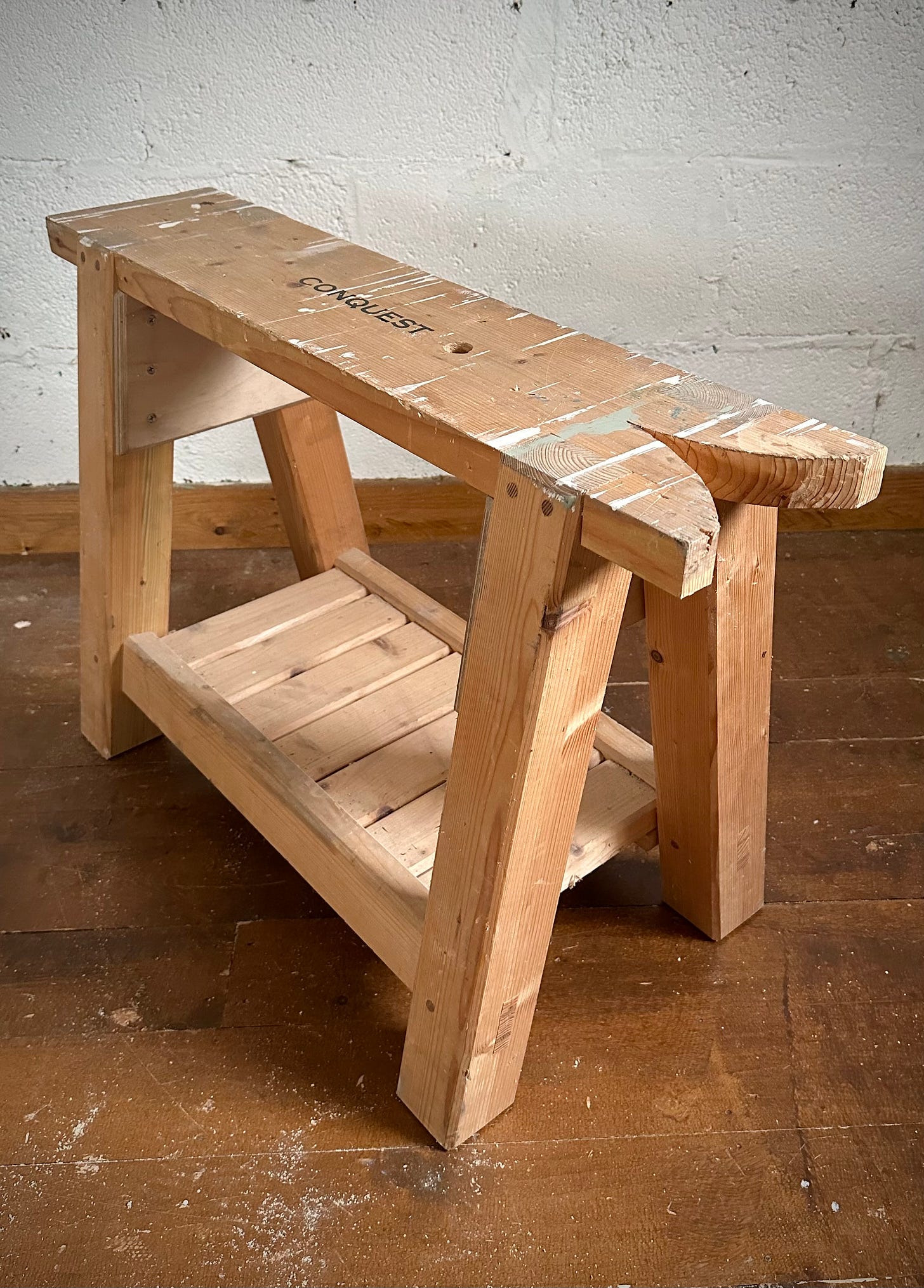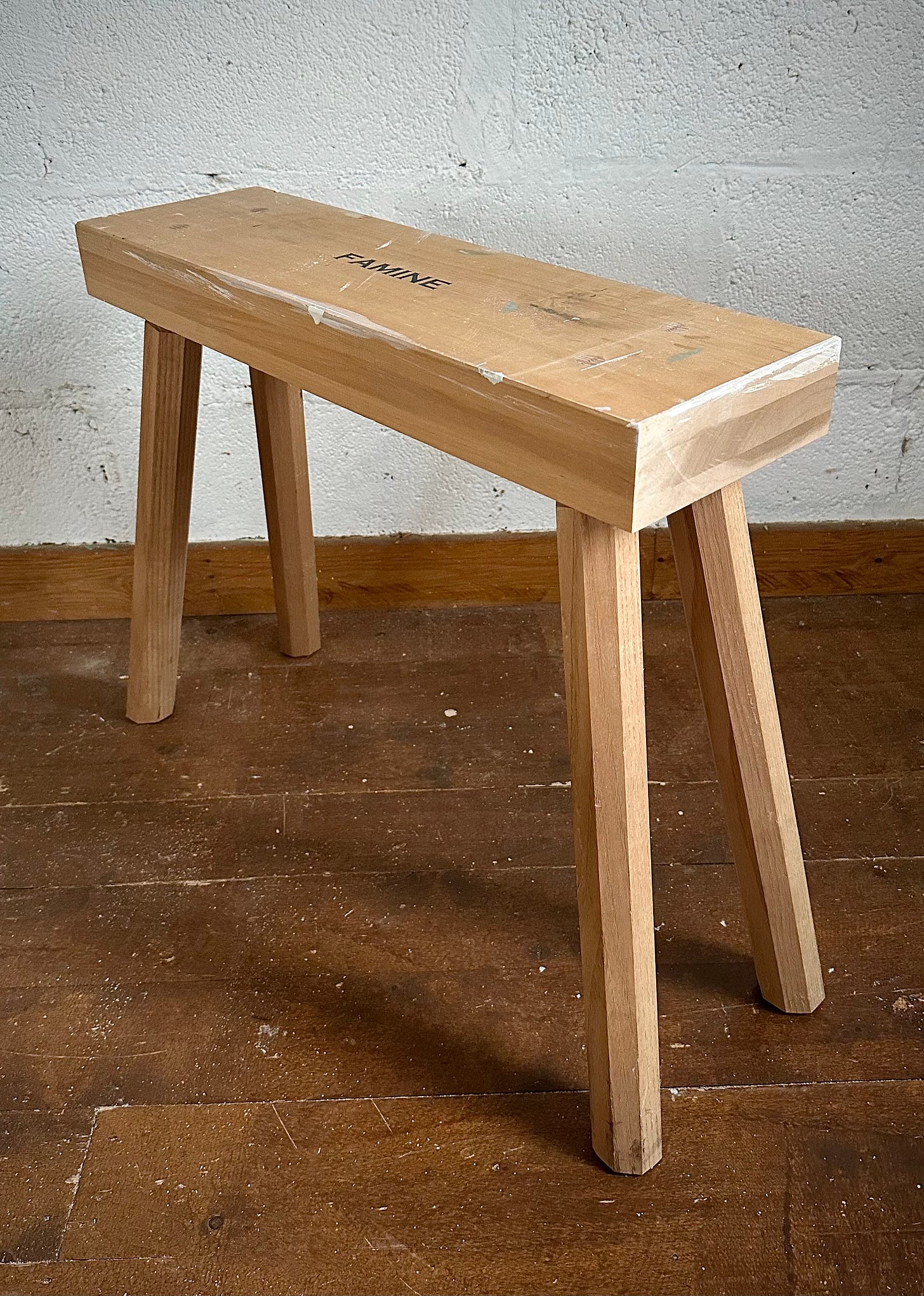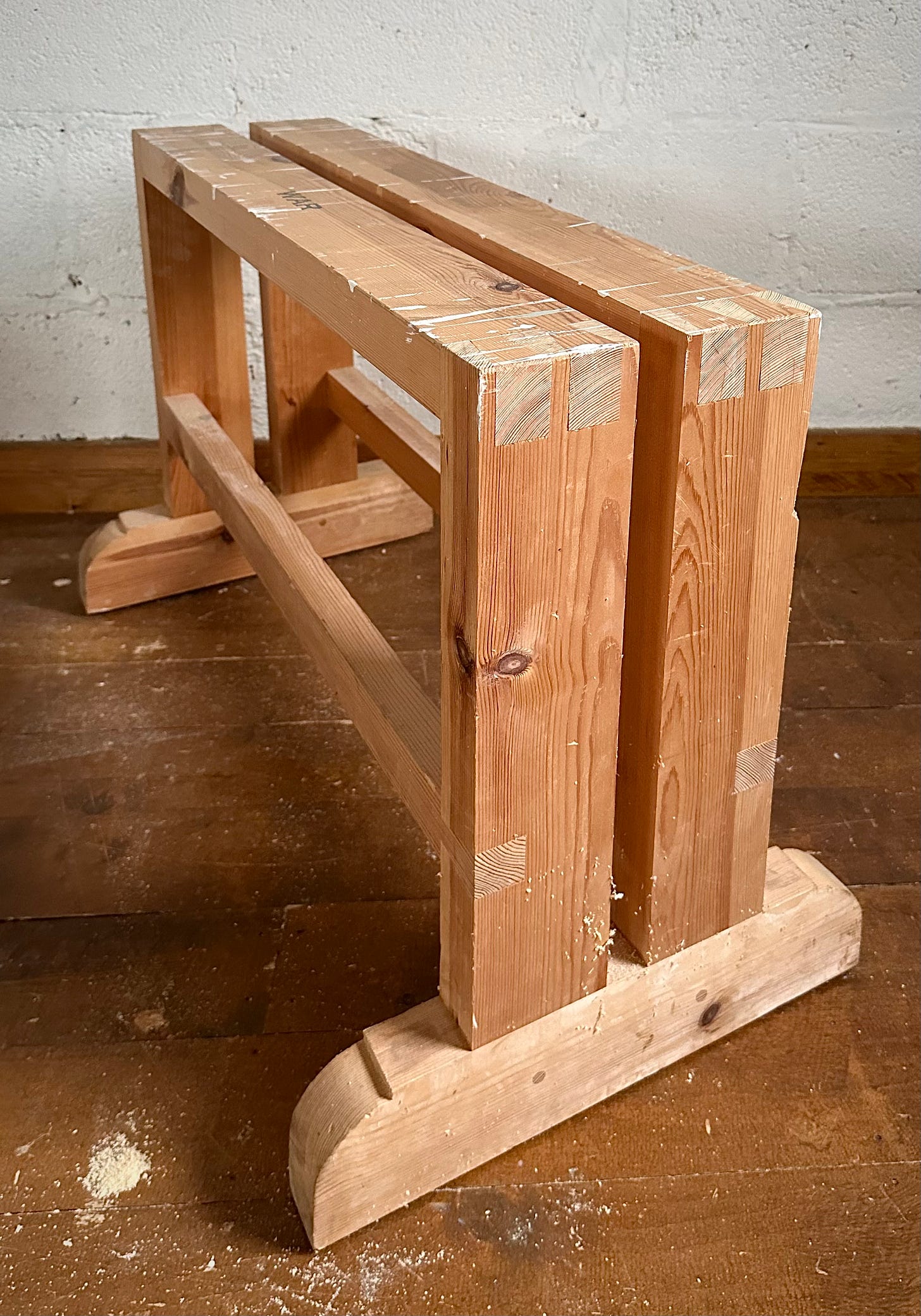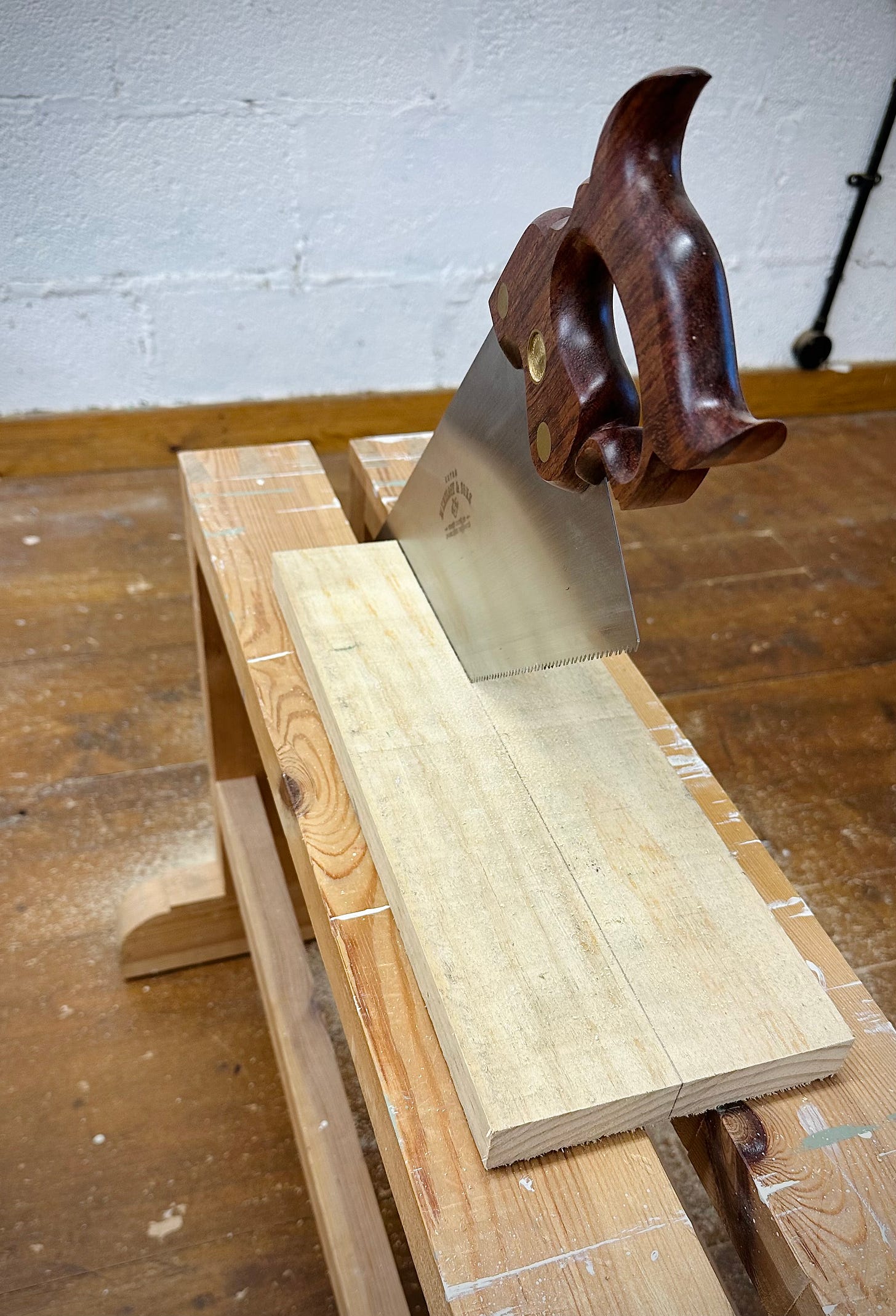The Saw-Thru Bench
Bifurcated for your sawing pleasure
I’ve had various saw benches in my workshop for many years. In fact I have four of them. The Four Sawhorses of the Apocalypse, as I like to think of them (except a saw bench is distinct from a saw horse, but I needed the corruption of terminology to make the pun work. Look, just go with it). For my own amusement I recently took the leap and labelled them accordingly. Now I can say to workshop visitors “have a seat on Death” or “ just pass me Famine over here”. It’s a bit of fun in an end-of-the-world kind of way. You may wonder if this is a bridge too far for a slightly thin joke. We were all thinking it, I just decided to stay silent on the matter.

The first I made, let’s call it Conquest, is a pretty traditional design. I followed Chris Schwarz’s Popular Woodworking article and it’s a solid beast. I couldn’t find the original article on the web, but it’s definitely out there somewhere as a free download.

The third and fourth I made, Famine and Death as we now know them, are of staked design. Again these are the design concept of Mr Schwarz, so blame him if you don’t care for famine and death. Chris covered the construction of these in The Anarchists Design Book. I thought the section on the saw bench had been published as a free download somewhere, but again I couldn’t find it. These are a great introduction to staked furniture and you can use the saw bench as a skills development exercise before tackling a stick chair.

But it’s the second, of my own design, that I brought you here to talk about. War.

As my namesake Edwin Starr told us:
“War, huh, yeah
What is it good for?
Absolutely nothing, uhh
War, huh, yeah…”
And so on.
Except that’s where the other Edwin got it slightly wrong. Saw bench number two, or War, is good for a few things.
You can saw straight through the middle of it. Now granted, you could do that with all of my saw benches, but it would be a rather final cut. This design has been developed specifically to suit ripping. As a blended woodworker I’d sometimes crosscut boards with a handsaw for convenience, but all ripping would be done on the tablesaw or bandsaw. As a hand tool woodworker, hand sawing is your only trick, so ripping becomes a key part of your skillset. Ripping small pieces is so much easier when the board has good support on both sides, which is where the Saw-Thru Bench really excels.
Many saw bench designs have raked and/or splayed legs (see Conquest, Famine and Death for instance). On the face of it this is logical and is done to aid stability. The downside is that to avoid crosscutting into the legs, the cut line must be shifted outward from the bench. This arguably reduces the stability which the raking leg was meant to create in the first place. The Saw-Thru Bench has vertical legs, allowing sawing to be done right next to them. Stability is achieved with a wider horizontal member at the base. You’ll just have to take my word for it, but the Saw-Thru Bench is as stable as any I’ve used. I staple a little pad of composite recycled rubber on the underside of all four corners so it doesn’t slip about in use.
It’s a study in joint cutting and would be an ideal teaching project. There are oversize dovetails, wedged and drawbored through mortice and tenons, and half lap joints. There’s some cross-cutting, ripping and curve cutting to do. The chunky dovetails allow a bit of showing off if that’s what you’re into. And it doesn’t contain a single metal fastener.
It’s all made from 2x4 material that you could pick up at a home centre. That makes it a project accessible to more or less anyone. I used unsorted Redwood, but any softwood would do. I can’t really see any advantage in making it from hardwood. Saw benches and horses get knocked about. Mine carries the wound of someone else’s wayward sawing on a Dutch Toolchest course (just saying. It wasn’t me). As you can see, mine also get used for painting jobs as well as sawing. I don’t deliberately let damage occur to them, but I also don’t fuss over them like I do my bench. I will be buried with that thing, Viking style.
When you want to pick it up, your hand naturally finds the central slot, meaning you can carry it single handed without being out of balance. Most other designs are a two-handed affair when it comes to moving.
I’ve reverse engineered a Sketchup model, which you can download for free here.
Notes on sizing.
The height of the bench in the Sketchup model suits my proportions. I’m a modest 5‘8”, so bear that in mind when sizing to yourself. You need a bench that comfortably allows you to stand alongside, with one knee up on the workpiece. Your body weight (whatever that might be, no judgement here) is what holds down the work. The length from the underside of your bent knee to the floor is key. So if you are a 7 foot tall freak you’ll need to make it higher than I do. Though made at different times, I’ve set all my saw benches to exactly the same height, so they can be used together when required. In fact I also made my Roman workbench the same height. Sometimes I use that as a giant saw bench. But mostly visitors sit on it because they feel weird about sitting on War or Conquest.
I can’t claim to be the first or only person to think of a saw bench with a slot up the middle. What I can say is that I’ve tested this design extensively and it’s very effective, as well as being bombproof. Give it a go. Then label with pride according to your belief system and/or sense of humour, or lack thereof.
All hail the Four Sawhorses of the Apocalypse.




Being an immodest 5’8” myself, I plan to take full advantage of your work so as to make my own saw-thru bench. My first thought is to call it the Banana Split bench, but that’s not really in the spirit of the thing, or so it seems to me. So I’ll try to come up with something more suitable.
As I type this, I’m watching the ManU-ManCity match, and Marcus Rashford just scored through the legs of Ederson, City’s keeper. So maybe I’ll call it Nutmeg. Which will confuse most everyone else, which could be fun. Then again, why am I even thinking about a name for a sawbench?
Ah, well. I think I’ll just make the Bifurcated Ripping Bench and be done with it.
I made a very similar sawhorse (Stumpy Nubs design), and I love this design, even though I have never made or used the other forms to compare against. I may make one of the staked versions for the exercise, if nothing else, however. The only thing I found with this, which I suppose would be a challenge for me with any sawhorse design, is that I find my body to be incompatible with the concept of work-holding with my knee. I think I set the height correctly for myself, but even still, trying hold the work with my bent leg, felt awkward, uncomfortable and at times painful. I don't know if I have an above-average bone protrusion directly underneath my knee-cap or not, but whatever it is, it hurts, and I don't like it. Problem easily solved with a lot of hold fast holes!